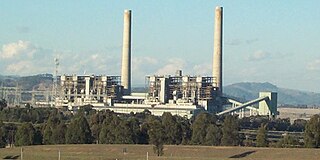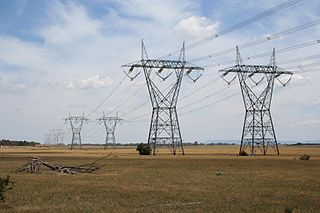The National Electricity Market (NEM) is an arrangement in Australia's electricity sector for the connection of the electricity transmission grids of the eastern and southern Australia states and territories to create a cross-state wholesale electricity market. The Australian Energy Market Commission develops and maintains the Australian National Electricity Rules (NER), which have the force of law in the states and territories participating in NEM. The Rules are enforced by the Australian Energy Regulator. The day-to-day management of NEM is performed by the Australian Energy Market Operator.

ActewAGL is an Australian multi-utility joint venture company provides utility services in the Australian Capital Territory (ACT) and south-east New South Wales. The company was formed in October 2000 between the Australian Gas Light Company and ACTEW Corporation.

White Cliffs Solar Power Station was Australia's first solar power station. It is located at White Cliffs, New South Wales, which was chosen as it has the highest insolation in New South Wales, and in 1981 when the station was constructed had no grid connection.

Liddell Power Station is a decommissioned coal-fired thermal power station that had four 500 megawatts (670,000 hp) EE steam-driven turbine alternators, providing a combined electrical capacity of 2,000 megawatts (2,700,000 hp).

AGL Energy Ltd is an Australian listed public company involved in both the generation and retailing of electricity and gas for residential and commercial use. AGL is Australia's largest electricity generator, and the nation's largest carbon emitter. In 2022, 83% of its energy came from burning coal. It produces more emissions as a single company than the nations of New Zealand, Portugal or Sweden, according to its largest shareholder, Mike Cannon-Brookes, who named it "one of the most toxic companies on the planet".

Solar power is a fast-growing industry in Australia. As of September 2023, Australia's over 3.60 million solar PV installations had a combined capacity of 32.9 GW photovoltaic (PV) solar power, of which at least 3,823 MW were installed in the preceding 12 months. In 2019, 59 solar PV projects with a combined capacity of 2,881 MW were either under construction, constructed or due to start construction having reached financial closure. Solar accounted for 12.4% of Australia's total electrical energy production in 2021.
Project EnergyConnect is a new electricity transmission line under construction which will connect the South Australia and New South Wales districts of the National Electricity Market in Australia. Riverlink was a previous working title for the project, drawn from a proposal first raised in 1999. The Australian Energy Market Operator used RiverLink in its proposal for this interconnector, but the transmission companies in South Australia (ElectraNet) and New South Wales (TransGrid) now call it EnergyConnect.

Energy in Victoria, Australia is generated using a number of fuels or technologies, including coal, natural gas and renewable energy sources. Brown coal, historically, was the main primary energy source for the generation of electricity in the state, accounting for about 85% of electricity generation in 2008. The amount of coal-fired power has decreased significantly with the closure in 2017 of the Hazelwood power station which supplied around 20% of Victoria's electricity, and to a lesser extent with the exit of Anglesea power station in 2015. Brown coal is one of the largest contributors to Australia's total domestic greenhouse gas emissions and a source of controversy for the country. Australia is one of the highest polluters of greenhouse gas per capita in the world.
The Silverton Wind Farm is a 199 megawatt wind farm situated on the Barrier Ranges in New South Wales, built for AGL Energy by Catcon and General Electric.
The Australian Energy Market Operator (AEMO) performs an array of gas and electricity market, operational, development and planning functions. It manages the National Electricity Market (NEM), the Wholesale Electricity Market (WA) (WEM) and the Victorian gas transmission network. AEMO also facilitates electricity and gas full retail contestability, overseeing these retail markets in eastern and southern Australia. It is additionally responsible for national transmission planning for electricity and the establishment of a Short Term Trading Market (STTM) for gas.
South Australia is a leader in utility-scale renewable energy generation, and also produces gas and uranium for electricity generation. Gas production is mostly concentrated in the Cooper Basin in the state's north-east. Gas is delivered from these fields by pipeline to users interstate and to Port Adelaide where it fuels three separate gas-fired power plants. Uranium is also mined in South Australia, though nuclear power generation is prohibited nationally. The Olympic Dam mine is the world's single largest known deposit of uranium and represents 30% of the world's total uranium resource. Many utility-scale wind farms and solar farms have been commissioned during the 21st century and geology with potential for geothermal energy has also been identified but is yet to be developed.
Macquarie Generation is an electricity generation company in New South Wales, Australia, owned by AGL Energy, and has a portfolio of generating sites using predominantly thermal coal power. The company now trades as AGL Macquarie and generates electricity for sale under contract.

The electricity sector in Australia has been historically dominated by coal-fired power stations, but renewables are forming a rapidly growing fraction of supply. In 2021, Australia's electricity production reached 265 TWh, with coal accounting for 52.9% and natural gas for 18.8%. Renewable sources, comprising solar, wind, hydro, and bioenergy with waste, collectively made up 26.7% of the total electricity generation mix.

The Nyngan Solar Plant or Farm is one of the largest operating solar plants in Australia. At the time of construction, it was the largest solar plant in the southern hemisphere. It is located 10 km west of Nyngan in western New South Wales. It was built and is operated by AGL Energy.

The Broken Hill Solar Plant, which became operational in December 2015, is a 53 megawatt farm located near Broken Hill in western New South Wales, Australia. It is associated with the Nyngan Solar Plant, making the total capacity of the combined plants 155 megawatts.

Energy produced in the Australian Capital Territory mainly consists of solar electricity. Electricity consumed in the Australian Capital Territory mainly comes from the national power grid through substations at Holt and Fyshwick. The ACT currently mandates that 100 percent of its electricity, will be supplied from renewable sources by 2020. The ACT has five solar farms capable of generating about 56.3 megawatts. From 1913 until the mid 1950s some power was produced from the Kingston Powerhouse, a thermal power station in Kingston.
Limondale Solar Farm is a solar farm south of Balranald in southwestern New South Wales, Australia. When it was completed, it was the largest solar farm in Australia. It is owned by German company RWE through a subsidiary Belectric Solar and Battery, and was constructed by Australian engineering company Downer Group.









